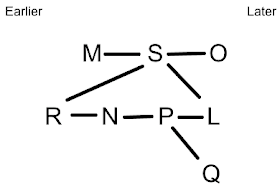 I've received several requests for a diagram of my Pure Sequencing LSAT Logic Game, so here goes.
I've received several requests for a diagram of my Pure Sequencing LSAT Logic Game, so here goes.This blog post includes my version of the main diagram for this Logic Game. It also includes modified versions of the diagram for questions 4 and 5, which introduce new limitations to the main diagram.
***
Also see my explanation of this game's set-up in Logic Games Pure Sequencing Step-by-Step Diagram.
***
I don't normally write "earlier" and "later" on the diagram because linear/sequencing games usually involve putting things in order from earlier -> later.
For this reason, left -> right usually means earlier -> later, and it's come to feel natural. However, some of you are still learning, so I included it in the below diagrams.
Here's the main diagram (click to enlarge):

Here's the diagram for Question 4 (click to enlarge):

Here's the diagram for Question 5 (click to enlarge):

Photo by dannysullivan / CC BY 2.0
(It's from the episode "Sword of Destiny" in the TV show Arrested Development. GOB and Buster perform a magic act together, and Buster accidentally cuts off GOB's fingers. I can't believe someone actually made Lego scenes based on a TV show either. I love Arrested Development, but Lego scenes are a bit much.)
This approach is waaaaaaaay easier to use (and much less confusing) than the set-up models offered by Logic Games Bible. I've found that writing down each individual rule LGBible-style (i.e., M > R)first before creating a model like Steve's has been helpful to me. It can be tricky to go from the rules text straight into a sequencing diagram, especially if you're new at it.
ReplyDeleteI concur and completely agree! I saw it and was like, 'This is so much more like my natural mind thinks"
DeleteI concur and completely agree! I saw it and was like, 'This is so much more like my natural mind thinks"
DeleteI agree with Joey, this way is much easier. Using the LGB way is helpful in some simpler games but in the more complex ones I tend to make false assumptions based upon the spatial placement of the variables.
ReplyDeleteActually, as the result of doing this game and seeing how Steve's diagrams are set up from this game I'm starting to develop one more like the ones used here except I try to keep variables that are interchangeable right above one another. In the original setup I just moved M and S over above R and S respectively while keeping O above L.
I'm gonna now go back over some of the linear games I've already done and see how it works. Thanks!
Thank you so much! I'm just wondering: I've been drawing similar diagrams for sequencing games vertically instead of horizontally. What's your opinion on vertical versus horizontal representation?
ReplyDeleteSteve,
ReplyDeleteThank you for all this great practice!!!! I got the diagramming right, but can you explain to me question 2? Why can't "o" be third? With the M-S-O string, o can't be in slots 1 or 2; M can't be in slots 8 or 7; and S can't be in slots 1 or 8. We know M & R go before S, but we don't know which one. With the R-N-P-L string, P can perform third. Help! Emilie
I have trouble understanding how you are using the diagram. How are you assigning the number sequences to each letter relative to the pathways? I understand the pathways move from earlier to later, but the fact that some pathways are parallel is really confusing me. Any light you could shed would be much appreciated!
ReplyDelete@Anonymous:
ReplyDeleteThis may be a bit late, but O can't be third because:
O must come after S
S must come after both M AND R.
Therefore, the earliest O can be is fourth, no matter what order M and R are placed.
Can anyone tell me why answer for question 2 is not D?
ReplyDeleteOption D is stating that P CANNOT be third, but it can! If you look at the diagram, for P to perform, you only beed N and R before it. I'm *assuming* you're getting tripped up because it sort of looks like both N and S need to come before P if you're looking at the diagram...BUT the diagram is simply indicating that R needs to come before S and N, not that both S and N need to come before P. I hope that makes sense!!
DeleteI can't follow how you made these diagrams. How do we know when to add the second line? Can you give us a step-by-step tutorial of how you came up with this particular diagram?
ReplyDeleteI agree with Geoffrey. I am completely confused on where to start. Any help would be greatly appreciated as I've invested in the day-by-day version. Thanks.
ReplyDeleteWow diagramming your way is much easier than the Logic Bible way. They really over complicate with all of their symbols. Thanks!
ReplyDeleteYeah I agree but just practice the diagramming drills in the LGB and use his style. This question is just more difficult so you have to work your way up to these kind of games.
ReplyDeleteYUP, me too, I have paid my money, and this Blog is decent, but I am surprised there is no set-up explanation for the set-up diagram other than that it is better than the diagram configuration outlined in the Bible.
ReplyDeleteHelp Steve!
N.
Hey Steve,
ReplyDeleteJust bought your 4 month plan as well as the supplemental materials from you.
I would like to know if you just constantly referred back to the Diagram itself or you made some inferences that could save time on the questions that we might not be aware of. I would like to increase my speed for sure and it seems like even if you have a clear diagram such as yours, it still takes some time to suss out the the order possibilities for the different questions. It seems to involve a lot of looking back and forth from answer choices to diagram!
Finally, I was wondering if you could give insight into how you created your diagram. It seemed to create itself perfectly and seemingly naturally. I usually put arrows at the end of the lines since a line with no arrowhead at the end kind of confuses me. But I guess that's a preference thing.
Thanks again! Great practice.
Hey guys - just to make sure you saw, I've granted your wishes and done a blog post with a step-by-step setup of this Logic Game.
ReplyDeleteHope it helps!
Hey Steve,
ReplyDeleteHow do you use your diagram style to depict possible equality. For example (from the LGB): Jahru is not faster than Miles. Do you just wait to draw it on the diagram until you have found more information, or do you use the greater than equal to sign.
Thanks,
Amish
I believe "pure sequencing" problems are those that only one element occupies each space, and their are not equal ones, or shared spaces. Someone correct me if I'm wrong...
ReplyDeletedo any of you find that you end up drawing two diagrams? one with diagonals because you're not sure where things will end up. then one with the lines neatly across as Steve does in this exampe. just not sure howd you'd create the easy to read one off the bat...there's simply no way to know how to make the branches horizontal or diagonal at first.
ReplyDeleteWhere do I find the multiple choice answers for this game?
ReplyDeleteI also agree with Joey!
ReplyDeleteI am having difficulty diagramming the following game:
ReplyDeleteExactly 6 piano classes are given sequentially on MondayL 2 with more than 1 student and 4 qith exactly 1 student. Exactly 4 females---Gimena, Holly, Iyanna, and Kate--and 5 males--Leung, Nate, Oscar, Pedro, and Saul--attend these classes. Each student attends exactly one class. The following must obtain:
- Iyanna and Leung together must constitute one class.
- Pedro and exactly two others together must constitute one class.
- Kate is the first female, but not the first student, to attend a class.
- Gimena's class is at some time after Iyanna's, but at some time before Pedro's.
- Oscar's class is at some time after Gimena's.
Please someone help diagram this for me?
Thanks!
ps. Steve is AMAZING!
Where's the actual answers to the questions? Stece says highlight the white to get the answers, I only see the diagrams. What am I missing?
ReplyDeleteSteve,
ReplyDeleteI found question 3 to be difficult. Can you explain how you got to that particular answer and why its a better fit than some of of the others? Thanks!!
I'm working on day one, and I just completed your pure sequencing and took forever. Then I read your explanation and diagram, read the bible pages 272-292, used your diagram for the problems (which was much simpler) and got all the diagramming drills correct and flew through the Decemeber 2000 Questions. Seriously it took me maybe 5 minutes. This is an amazing feeling, Steve. Thank you!
ReplyDeleteHi Steve,
ReplyDeleteAfter having used LGB diagramming exclusively Though I do love LGB), this is incredibly helpful and more succinct. Thanks! But I've always had a question that's touched on in the first comment. LGB recommends that you "fix the variables and rules firmly in your mind", as an essential tool for owning games. Do you agree, and if so, do you have any suggestions for memorizing all of the rules the first time you read them? I often notate rules (M>S) to the right of rules as I read, and then diagram. I also constantly revisit rules when diagramming, and it's a huge time-suck. Any advice/suggestions are welcome. Thanks again!
Steve, you are a saint! I also have started Day 1 today on your day-by-day 2 month study schedule. I had an ah-ha moment: make the diagrams as linear as possible. It is so much easier to track the relationships between the variables. I know this may sound obvious, but for those who are visual learners, it is a must. Thanks for your post.
ReplyDeleteJust stumbled across this, good info. Thanks. The only thing that is wrong here is that GOB is not a magician...he produces illusions. ;P lol
ReplyDeleteHey Steve, thank you vey much for this. I purchased your 4 moth plan. I have found that the link to the answers explanation for this particular problem goes directly to the diagram. Is there a page that exists with a full explanation of the answers? Please advise, thanks!
ReplyDelete-jilli
To answer your question, Jilli, the diagram is all the explanation you really need to understand the answers to each of the questions. And good luck studying! I too am using the 4 month plan. ^.^
ReplyDeleteP > L/Q
ReplyDeleteS > O/L
M > S
N > P
R > S/N
Inferences:
1) N > P > L/Q
2) M > S > O/L
3) R > S/N
Notice how inferences 1 & 2 Share the variable L and keep that in Mind.
Also keep in mind that the only variable that absolutely controls Q's position is P.
Then begin diagramming using Steve's style and hopefully it will make more sense...
Do you recommend setting these diagrams up horizontally as opposed to vertically? I've seen it done both ways and cant figure out which way to follow...Thanks!
ReplyDeleteI do them vertically now , from bottom up -> with arrows Upwards and I understand it much 3asier
Deleteall i see is a diagram, i'm failing to see the explanation. can anyone help, so that I may understand this clearly?
ReplyDeleteI feel the same way! I cant really fathom how these diagrams help you to figure out the answer...
DeleteI have a question regarding diagramming. My diagrams arent exactly like yours. Some of the questions I get right and some I get wrong. The diagrams make sense to me though. I'm still using the left/right method to show which variable is before or after. Should my diagram be exactly like yours? Would the differences below the following example determine if I get a questions right or wront? Your diagram may have:
ReplyDeleteB
/
/
A to say that A is before B, but my diagram may have:
A------B to say that A is before B. Does it matter as long as I am able to link all of the variables together from left to right? Also, I'm a beginner and I wanted to know if the online logic games course goes into more depth regarding how to diagram than the explanations here on the site and in the study guide?
Hi there,
DeleteYou have some flexibility with regard to exact appearance of the diagram. Yours doesn't have to look exactly like mine in order to be correct or valid.
Yes, my online logic games course does go into more depth than the explanations you see on the blog and in the free videos I've created.
Hey! I understand the diagrams but where are the written explanations?
ReplyDeleteHi Steve. I really cannot make sense of question 5: if R is supposed to precede O in the initial instructions, how can R come after M & O in question 5 (it's also not reflected in your diagram). Am I just understanding the question wrong?
ReplyDeletePretty nice post. I just stumbled upon your weblog and wanted to say that I’ve truly enjoyed browsing your blog posts. In any case I’ll be subscribing to your feed and I hope you write again very soon! Feel free to visit my website; 안전놀이터
ReplyDeleteI must thank you for the efforts you’ve put in writing this blog. I am hoping to view the same high-grade blog posts from you later on as well. In fact, your creative writing abilities has inspired me to get my very own blog now ?? Thank you for the auspicious writeup Feel free to visit my website; 온라인카지노
ReplyDeleteAdmiring the time and energy you put into your site and in depth information you offer. It’s awesome to come across a blog every once in a while that isn’t the same outdated rehashed information. Excellent read! Feel free to visit my website; 토토
ReplyDeleteThis article is quite interesting and I am looking forward to reading more of your posts. Thanks for sharing this article with us. Feel free to visit my website, thank you! 스포츠토토
ReplyDeleteThank you for publishing a very informative post. Every post of yours is very awesome, we feel satisfied by reading it. Please keep writing such post further. Feel free to visit my website, thank you! 카지노사이트
ReplyDeleteIt is very well written, and your points are well-expressed. I request you warmly, please, don’t ever stop writing. Feel free to visit my website, thank you! 파워볼사이트닷컴
ReplyDeleteI was actually captured with the piece of resources you have got here. Big thumbs up for making such wonderful blog page. Feel free to visit my website, thank you! I was actually captured with the piece of resources you have got here. Big thumbs up for making such wonderful blog page. Feel free to visit my website, thank you!
ReplyDeleteGreat post! I am actually getting ready to across this information, is very helpful my friend. 경마
ReplyDeleteGreat blog here with all of the valuable information you have. Keep up the good work you are doing here 바카라사이트
ReplyDeleteI was looking for another article by chance and found your article I am writing on this topic, so I think it will help a lot. I leave my blog address below. Please visit once. 토토사이트
ReplyDeleteA high-quality blog has a lot of information and useful content. 검증된 1등 놀이터
ReplyDeleteI completely agree with the text. I was able to learn very accurate up-to-date information. 토토사이트
ReplyDeleteYour travel articles take me on a journey, even when I can't travel. Thank you for the virtual adventures!Abogado Invadiendo de Condado Essex
ReplyDeletePrevention of Domestic Violence Act New Jersey
ReplyDeleteThe Logic Games Pure Sequencing Diagram is a user-friendly tool designed to simplify the process of creating and understanding intricate game scenarios. It enhances visualization and efficient problem-solving, making it an essential resource for both beginners and advanced logic game enthusiasts. This diagram facilitates a strategic and systematic approach to conquer sequencing challenges in various logic games.
Thank you so much for sharing these diagrams. As someone still getting comfortable with sequencing games, having a visual breakdown like this really helps solidify the concepts. I especially appreciate the note about left-to-right representing earlier-to-later — it's a small detail, but it really helps with understanding the logic flow. Your step-by-step approach is super helpful, and I’ll definitely be checking out your other posts on game set-ups. Keep up the great work! Criminal Lawyer Northern Virginia
ReplyDelete